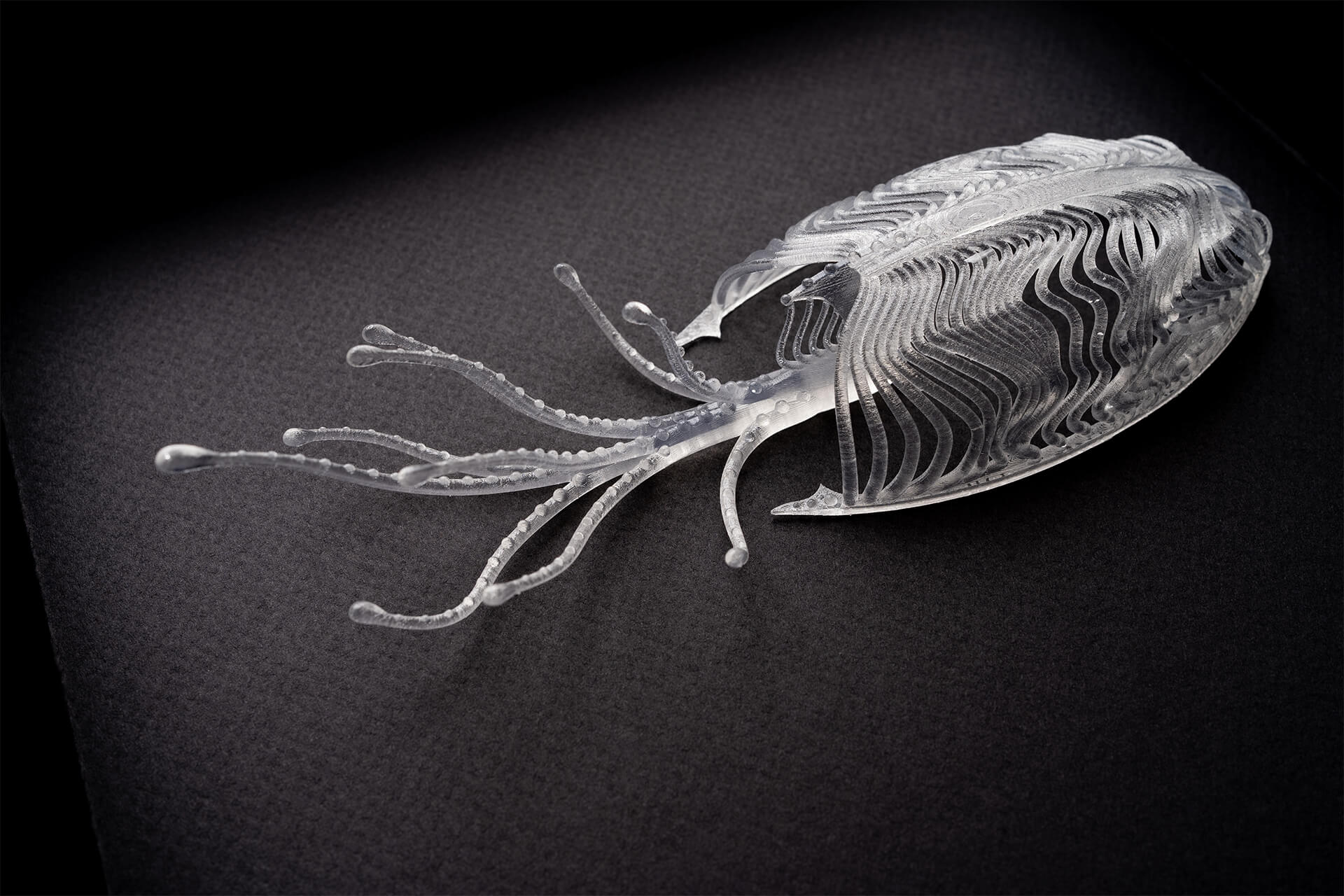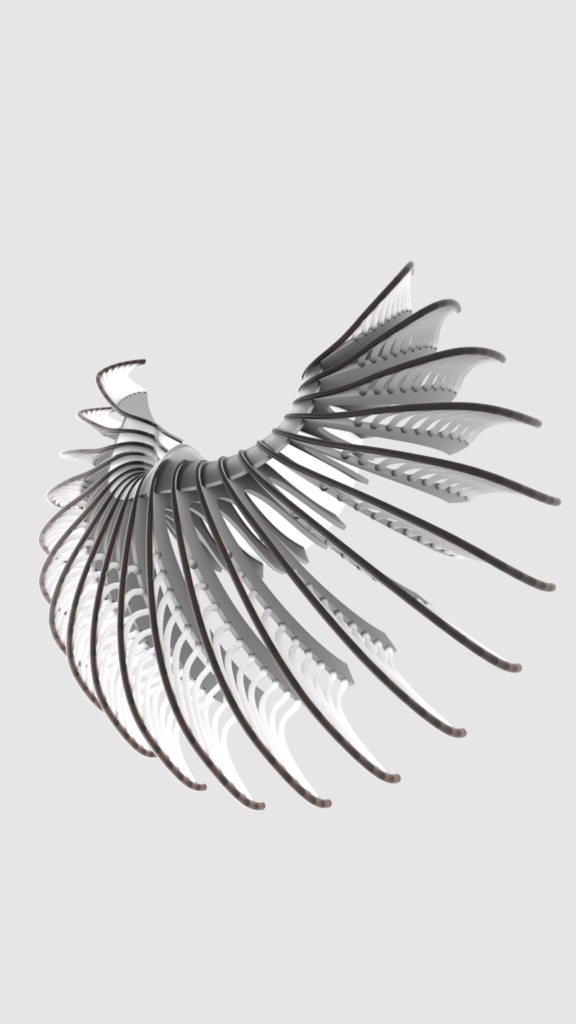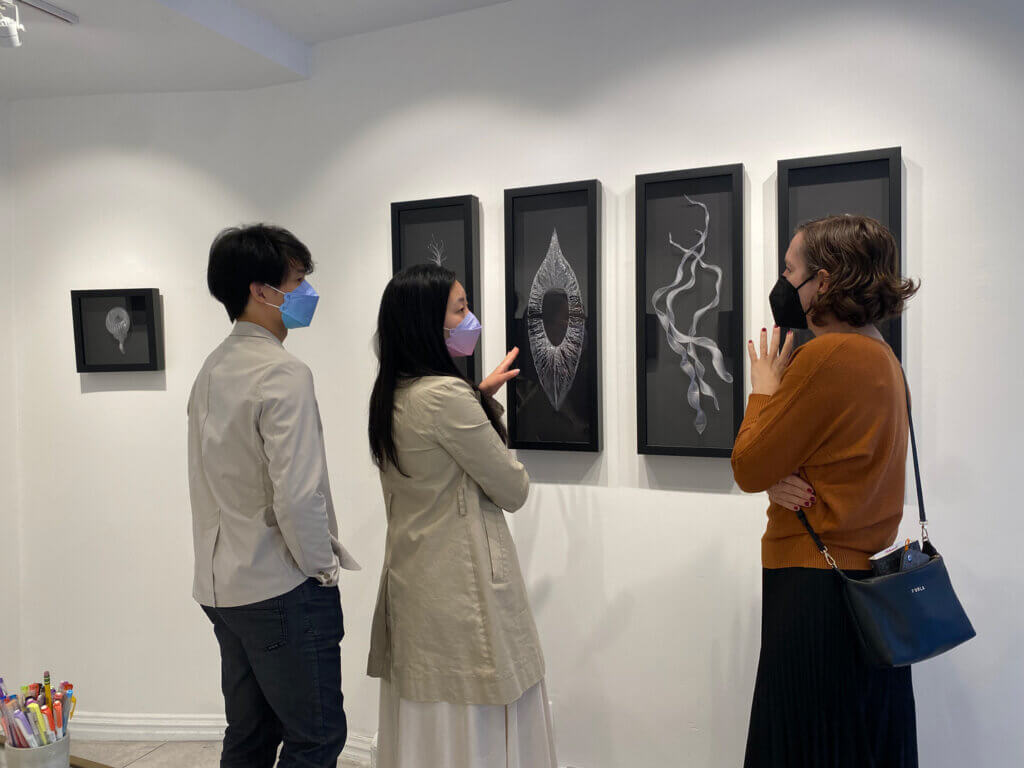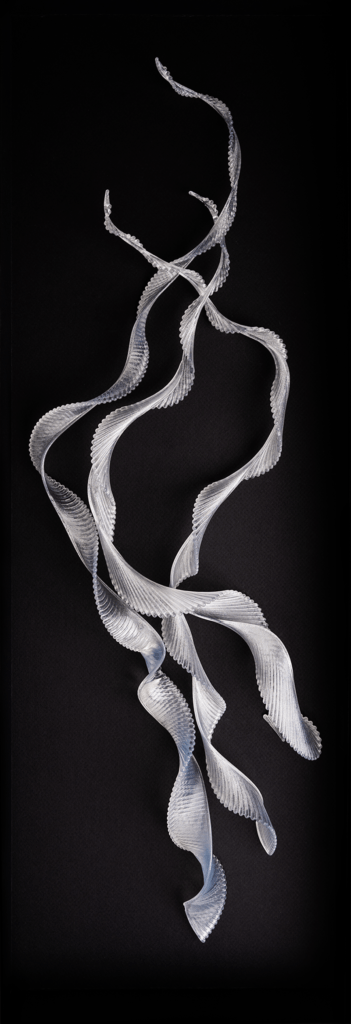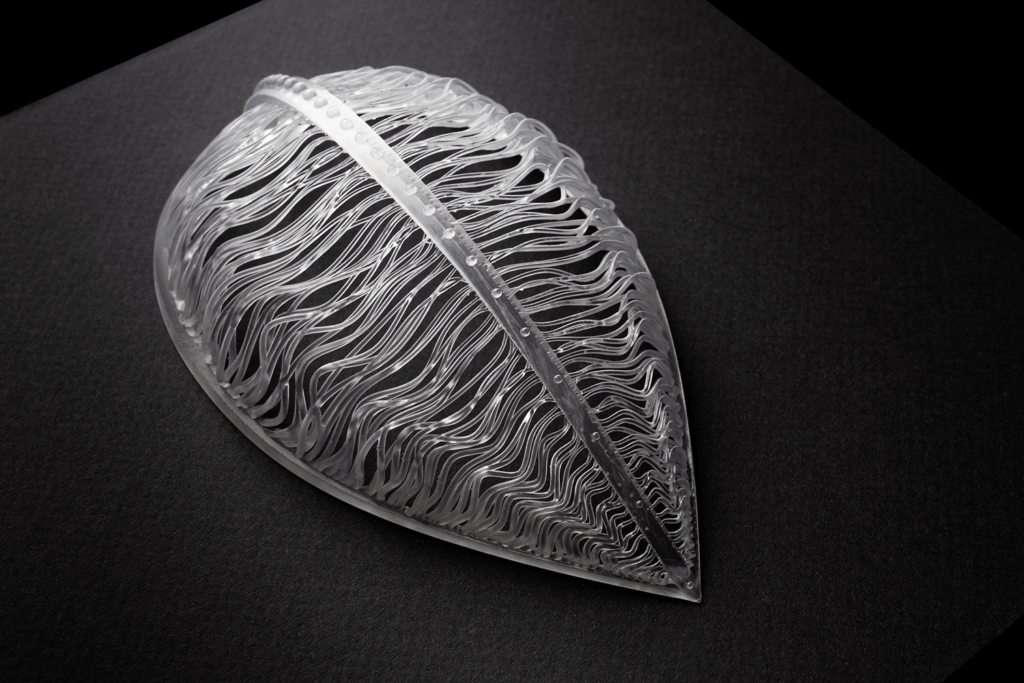Mary Franck: Specimens
September 15th – October 8th, 2022
EV Gallery
621 E 11th St, New York, NY 10009
Mary Franck’s sculptures are made out of layers of manual and algorithmic processes to create her imagined, 3D printed, resin specimens. Suggestive of plants, invertebrates, and multicellular colonies, relief sculptures of fantastical biological creatures combine with generative visual animations in Franck’s debut solo exhibition Specimens. I had the pleasure of interviewing Mary to understand more about her intersectional and multimedia practice.
CG: Firstly congratulations on your show! After reading more about you and your artistic history, I’ve learnt that you have exhibited works in a wide array of places like the Contemporary Jewish Museum in San Francisco, and at the Mutek Music Festival in Montreal. Is Specimens the first body of work you’ve shown in a small gallery space in New York City?
MF: Yes, Specimens is my debut solo show and my first gallery show in NYC. I was active in the arts communities of San Francisco when I lived there and showed often. The New Experiments in Art and Technology show at the CJM culminated that phase of my artistic life. The show included my artistic heroes: Camille Utterback, Jim Campbell and Alan Rath before he passed. I’ve also been fortunate to exhibit and perform in a number of international art festivals, like Mutek, Sónar, and нощ (Night) in Bulgaria. Much of my past work has been ephemeral site-specific installations and performances.
CG: What sparked your initial interests in biological and organic matter?
MF: My interest in biology, especially its shapes and beauty, began in my childhood playing in the forest and observing the natural world. I still do this as an adult–for me it’s a form of meditation, to spend time in close observation of complex forms and systems. Now this particular meditation takes me to nature preserves and on SCUBA diving trips–there’s a clear oceanic theme to Specimens. My approach is not scientific, it’s artistic–I internalize these forms and patterns to feed my imagination. When developing a design, if it initially looks too much like a real creature, I re-work it to make it my own. These are figments of my imagination, materialized.
CG: Maybe in following with the previous question, how did you settle on using 3D modeling software in order to create something authentic to your ideas?
MF: I created this series by layering geometries that I draw in 3D with geometries that I generate with algorithms. I move back and forth between these techniques until I’m satisfied with the piece. For example, I may model the surface of a shell, then write an algorithm to grow tendrils along that shell, then perform other modeling operations on those subsequent tendril geometries. To make a piece I like, I may iterate on the 3D drawing and modeling over and over; sometimes I tweak the algorithms for days or weeks to get the right look. I’m drawn to this process because I’m able to create more intricate and complex forms than I could in other mediums.
I’ve been using these tools long enough that I can use them fluidly and expressively. Specimens continues work I’ve been doing for over a decade. I learned how to use 3D modeling tools in architecture school and studied computational geometry with Satoru Sugihara. I learned the fundamentals of computer graphics from my mentor Steve Mason—I see my work as continuing in the lineage of computer arts pioneers like Lillian Scwartz and Larry Cuba. 3D modeling is a powerful tool for shaping our world and realities, whether through the design of buildings or through visual fiction.
CG: The Specimens sculptures are made out of resin, a material associated with the preservation of insects like butterflies and beetles. Was this a convenient, or deliberate choice of yours while working on the show?
MF: There’s a feeling with digital artwork that it’s immaterial, and that’s a feeling I want to resist. There are tangible, physical and social consequences to our digital lives and expressions. The forms I created for Specimens could have been released only virtually, but I find it more interesting to bring them back to a material expression. While I chose resin for its aesthetic qualities of detail and translucence, the history of the medium is a reminder that new tools are not separate from older practices. This is not a Platonic medium without character, history, or associations of its own.
CG: Can you please explain what an AI neural network is, and how it has helped craft Specimens?
MF: Specimens alludes to the way virtuality supplants the natural world with synthetic ones. This series imitates natural patterns and beings using computational geometry. Geometry is an ancient art, now used to simulate and fabricate reality through VFX and the tensor calculations of AI neural networks. While the natural world becomes degraded and more remote, fully imaginary worlds created through computation proliferate.
VR and AI are darlings of our current moment of computation and culture. Artists use AI tools like Midjourney to create stunning work, and design imaginary environments for the metaverse and virtual reality. In response to this cultural moment, I want to draw attention to our computational tools. To be clear, while Specimens is created with algorithms, I don’t use AI at this time in my practice. Rather, I’m inspired by the fundamentals of mathematics and geometry, and notions of the natural and unnatural. There is a false dichotomy between the natural and unnatural, the imaginary and the real.
In fact, the imaginary and the real intertwine and shape each other. Geometry was first developed in antiquity in Egypt to define property boundaries after the Nile’s annual floods, using points, lines, and vectors. Tensors, the fundamental units of neural networks are n-dimensional vectors, used to calculate, for example, the linguistic “distance” between two words. The 3D modeling software I use also lends itself to visual effects for films and simulations for the metaverse. Geometry, once used to describe the world, now replaces it. I situate my work in this continuum, using computers to mathematically describe imaginary beings that I materialize as real objects.
CG: Why is it important for each 3D sculpture to be accompanied by a corresponding generative animation?
MF: Most of my work is time-based because I’m fascinated with presence. In my performance work, I use real-time tools to make imagery that exists only in the moment of performance with the audience. Likewise, my installation work usually uses real-time elements to have unique, non-repeating moments of physical expression. Art can be so many things: eternal, disposable, impersonal, intimate. Real-time expression creates an immediacy and intimacy that I value. My larger sculptural commissions have been digitally-integrated sculptures that combine materiality and form with changing animation.
This series departs from my time-based practice. Relief sculptures are more accessible for collection, one of my goals for engaging a wider audience. To continue the spirit of my larger body of work, I see these sculptures as “still-frames” of a longer digital life: the corresponding generative animation is that digital life. Within the series concept, I think of the animations as showing the living specimen, some of which have features that are not “preserved” in the ossified 3D print.
CG: Out of all of your sculptural forms, which has been the least successful to you?
MF: Specimens succeeds in demonstrating range within a unified theme and set of motifs; the relationships between the individual pieces define it as a series. Fifteen pieces is a large series, but there are even more forms that remain on my harddrive. I think for every specimen in the series there’s another in my computer that I didn’t print. Every artist makes things that don’t work, that’s part of the process. Moving through the challenge that presents can lead to some of the most interesting artworks. Of course, I love the feeling of having an idea come out of the process as I imagined it, looking great.
But that’s rare. I actually find it more satisfying when I start with an idea and it doesn’t work, but the process leads me to something that surprises me, that I didn’t originally intend. I accept that not every idea will make it through the process, and that some ideas require more work than others. Three of the pieces in the show I printed then redesigned. Most of the pieces required iteration to be printable. I like the challenge of working at the edge and pushing the boundaries of what’s possible.
CG: Which has been the most successful, and why?
MF: Specimen 03 is a favorite of mine because it’s one of the most intricate. I pushed the boundaries of the printing technique with this form, I had to redesign it three times to print it. The fins on the bell arches are half a millimeter thick–it’s incredibly delicate. It feels both like fauna, with its medusal bells, and like flora with its reaching pistils. Specimen 12 is most suggestive of the idea of specimen collection–it’s a triptych of partial anatomies from other designs and captures the idea that this is an archive of creatures.
CG: Can you explain the video element to the show in a bit more detail? Are we seeing a sequence of all of the sculpture’s matching animations, or something else?
MF: The video in the exhibit is a series of stills from the animations. It shows the
specimens with features that are not “preserved” in the print, like gossamer membranes and fluid-filled veins. The scale of the video allows viewers to appreciate the finer details of the forms. It was conceptually important to me to bring a digital expression of the specimens into the exhibition.
CG: If you could go back and change anything about Specimens, what would you reconsider doing? Would your sculptures or videos be made using a different, methodical process? Would you still consider the same installation choices?
MF: When I discussed the opportunity with Kerri I felt that EV Gallery would be a perfect space for this series. While the themes are long-held for me, I designed the series for the gallery space: the scale and detail of the pieces fits the intimacy of this gallery. I came up with the mounting technique for the pieces for the show–the framing is all custom. I’m pleased with how the show came together and with how it’s been received. It’s been energizing and I look forward to starting a new and different series, and to developing these ideas for large-scale commissions.
https://www.instagram.com/bymaryfranck/
©2022 Mary Franck, Nicole Aptekar


